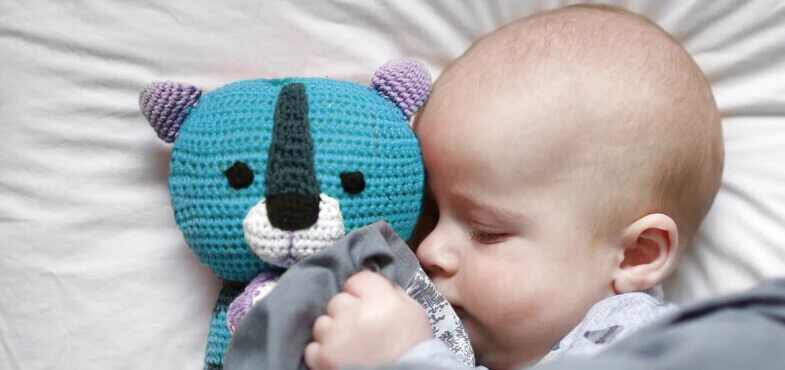Around the 3-month mark, your baby will start to sleep for longer stretches at night, but it’s important to keep to a night time baby sleep routine; not only so your baby continues sleeping well, but also because bath time, massage and cuddle time can mean so much more.
Newborn Baby Sleep Pattern
Sleep patterns begin to develop at around 6 weeks and most babies are developmentally capable of regular sleep-wake cycles by 3 to 6 months. As your baby begins to understand the difference between night and day, it’s the perfect time to help improve your baby’s sleep routine. Let us look at different ways in which you can make your baby sleep and help them adjust to effective sleep patterns.
How To Put Your Baby To Sleep?
Establish a Relaxing Environment
You can relax your baby by turning off the lights or giving them a soothing bedtime massage. A bedtime story can also be a great way to strengthen the bond between you two. It’s never too early for a story; this can also help develop language skills while you try to put your baby off to sleep.
Don’t worry about a dark room scaring your baby. Your baby is too young at this age to imagine anything scary, so it’s best to get them used to a dark room early-on!
Baby Bath
Give your baby a warm bath before bedtime as part of their baby sleep routine. A regular baby bath routine will signal ‘sleep time’ after every soothing bath. This way, you prepare your baby for sleep ahead of lying on the bed.
After the baby bath, you can use Johnson’s baby oil or Johnson's baby lotion to massage your baby.
Sing a Lullaby
Baby lullabies have been a part of baby sleep routines for centuries all around the world. Worry not about having the voice of a music icon; every baby is soothed by their mother’s voice. Check out our lullabies for babies, which you can sing to your baby or even listen to the lullaby together!
Talk to Your Baby
You can talk to your baby about what they did that day, and although they may not respond, your voice will soothe them. A lot like reading a bedtime story as part of your baby sleep routine, your voice plays a crucial role in helping your baby doze off to sleep.
Stay Flexible
As your baby grows, their needs change, and so will their sleep pattern. What worked last month may not work this month, and that’s perfectly okay. See and test what works best for the both of you. No rule is a rule; it’s up to you and your baby!
Teach Your Baby to Self-Soothe To Sleep
The most important aspect of getting your baby to sleep through the night is to have your baby learn to soothe themselves to sleep. Put your baby down to sleep when they’re drowsy but awake. Babies need to be able to fall asleep independently, so that they can self-soothe when they wake up in the middle of the night.
Frequently Asked Questions about Baby Sleep by Moms
Q.How Much Sleep Should My Baby Get?
After 3 months, babies will sleep 13 to 15 hours a day. It’s important to realize though that every baby is different, and some will need more sleep, while others need less..
Q.How Often Should My Baby Nap?
Your baby will also need to nap 2 to 4 times a day. Cutting back on naps won’t help at night — it can be a recipe for overtiredness and a worse night’s sleep — but avoid naps too close to your baby's bedtime.
Q.Things to Avoid While Sleep Training Your Baby
Make sure your baby’s sleep routine is not too long or too impractical to stick to. Avoid rocking or feeding your baby to sleep, because you may end up doing the same when your baby naturally wakes up during the night! Put your baby to bed when they’re drowsy but still awake and take turns with your partner in putting your baby off to sleep.
When you get your baby used to a certain way of sleeping, such as rocking during bedtime, they may always want to sleep that way. Make sure you get them used to a baby sleep routine that works best for both of you.
Q.Changes in Baby Sleep Patterns
Interestingly, your baby’s physical advances can alter sleep patterns, including their sleep routine. Many developmental milestones, such as rolling over and pulling up to stand, can temporarily upset your baby’s sleep. Don’t be discouraged if your baby, who once slept through the night, temporarily wakes up in the middle of the night. Stick to yourroutineto help your baby get back to a regular sleep pattern.
JOHNSON’S® 2-Step Baby Sleep Routine
Our JOHNSON’S® 2-Step Routine includes a soothing baby massage combined with the cuddles of quiet time; help your baby know that it’s time for sleep.

Safe and Sound
Your baby may do some things in his sleep that make you nervous — what’s normal? BabyCenter® helps you know what to look out for.
Moms around the world trust JOHNSON’S® to care for their babies
We are committed to working with moms, healthcare experts, and scientists to ensure our products continue achieving the highest standards in safety, quality, and care.
